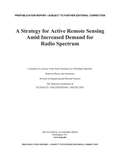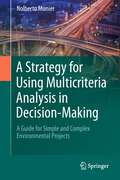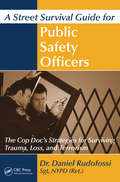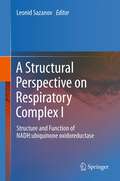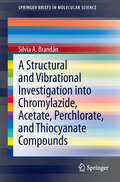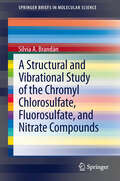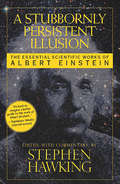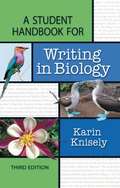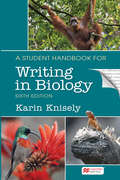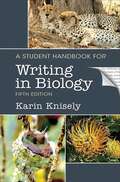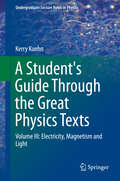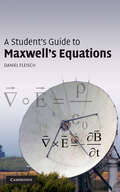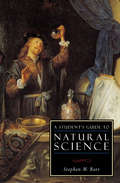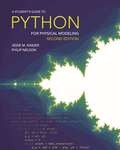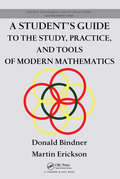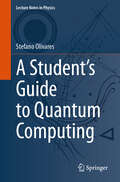- Table View
- List View
A Strategy for Active Remote Sensing Amid Increased Demand for Radio Spectrum
by Committee on a Survey of the Active Sensing Uses of the Radio SpectrumActive remote sensing is the principal tool used to study and to predict short- and long-term changes in the environment of Earth - the atmosphere, the oceans and the land surfaces - as well as the near space environment of Earth. All of these measurements are essential to understanding terrestrial weather, climate change, space weather hazards, and threats from asteroids. Active remote sensing measurements are of inestimable benefit to society, as we pursue the development of a technological civilization that is economically viable, and seek to maintain the quality of our life. "A Strategy for Active Remote Sensing Amid Increased Demand for Spectrum" describes the threats, both current and future, to the effective use of the electromagnetic spectrum required for active remote sensing. This report offers specific recommendations for protecting and making effective use of the spectrum required for active remote sensing.
A Strategy for Research in Space Biology and Medicine in the New Century
by Committee on Space Biology MedicineConstruction of the international space station, scheduled to start in late 1998, ushers in a new era for laboratory sciences in space. This is especially true for space life sciences, which include not only the use of low gravity as an experimental parameter to study fundamental biological processes but also the study of the serious physiological changes that occur in astronauts as they remain in space for increasingly longer missions.This book addresses both of these aspects and provides a comprehensive review of ground-based and space research in eleven disciplines, ranging from bone physiology to plant biology. It also offers detailed, prioritized recommendations for research during the next decade, which are expected to have a considerable impact on the direction of NASA's research program. The volume is also a valuable reference tool for space and life scientists.
A Strategy for Using Multicriteria Analysis in Decision-Making: A Guide for Simple and Complex Environmental Projects
by Nolberto MunierThis book develops a whole strategy for decision-making, with the full participation of the decision-maker and utilizing continuous feedback. It introduces the use of the very well-known and proven methodology, linear programming, but specially adapted for this purpose. For this, it incorporates a method to include subjective concepts, as well as the possibility of working with many different and even contradictory objectives. The book is liberally populated with diverse case studies to illustrate the concepts. This practical guide will be of interest to anyone undertaking analysis and decision-making, on both simple and complex projects, and who is looking for a strategy to organize, classify, and evaluate the large amount of information required to make an informed decision. The strategy includes methods to analyze the results and extract conclusions from them.
A Street Survival Guide for Public Safety Officers: The Cop Doc's Strategies for Surviving Trauma, Loss, and Terrorism
by Daniel RudofossiAn expansion of Dr. Rudofossi's theory of Police and Public Safety Complex Trauma, this text integrates other models of trauma and loss into a one-of-a-kind intervention model. It offers insider perspectives from police psychologists, police managers, and clinicians describing what police personnel experience on the job, along with expert intervent
A Structural Perspective on Respiratory Complex I: Structure and Function of NADH:ubiquinone oxidoreductase
by Leonid SazanovThe book contains chapters written by leaders in the research on the structure and function of respiratory complex I. It will provide a concise and authoritative summary of the current knowledge on complex I of respiratory chains. This enzyme is central to energy metabolism and is implicated in many human neurodegenerative diseases, as well as in aging. Until recently it was poorly understood on a structural level, and this book will provide a timely reference resource. Such a book was not published previously. The last time a minireview series on complex I were published was in 2001, and since then complex I field changed quite dramatically.
A Structural and Vibrational Investigation into Chromylazide, Acetate, Perchlorate, and Thiocyanate Compounds (SpringerBriefs in Molecular Science)
by Silvia A. BrandánA Structural and Vibrational Investigation into Chromyl Azide, Acetate, Perchlorate and Thiocyanate Compounds reviews the structural and vibrational properties of chromyl azide, acetate, perchlorate, and thiocyanate from a theoretical point of view by using Density Functional Theory (DFT) methods. These compounds are extensively used in organic syntheses and the study of their structure and spectroscopy has become fundamental. This book evaluates the best theoretical level and basis set to reproduce the experimental data existing for those compounds. To this end, the optimized geometries and wavenumbers for the normal modes of vibration are calculated and the obtained results are compared and analyzed. Also, the nature of the different types of bonds and their corresponding topological properties of electronic charge density are systematically and quantitatively investigated by using the NBO analysis and the atoms in molecules theory (AIM).
A Structural and Vibrational Study of the Chromyl Chlorosulfate, Fluorosulfate, and Nitrate Compounds (SpringerBriefs in Molecular Science)
by Silvia A. BrandánA Structural and Vibrational Study of the Chromyl Chlorosulfate, Fluorosulfate and Nitrate Compounds presents important studies related to the structural and vibrational properties on the chromyl compounds based on Ab-initio calculations. The synthesis and the study of such properties are of chemical importance because the stereo-chemistries and reactivities of these compounds are strongly dependent on the coordination modes that adopt the different ligands linked to the chromyl group. In this book, the geometries of all stable structures in gas phase for chromyl chlorosulfate, fluorosulfate, and nitrate are optimized by using Density functional Theory (DFT). Then, the complete assignments of all observed bands in the infrared and Raman spectra are performed combining DFT calculations with Pulay´s Scaled Quantum Mechanics Force Field (SQMFF) methodology and taking into account the type of coordination adopted by the chlorosulfate, fluorosulfate and nitrate ligands as monodentate and bidentate. Moreover, the force constants for each compound at the same levels of theory are calculated. As a result, the bond orders calculated and the topological properties of electronic charge density reveal the characteristics and nature of the different bonds in each structure.
A Stubbornly Persistent Illusion: The Essential Scientific Works of Albert Einstein
by Stephen HawkingBest-selling author and physicist Stephen Hawking assembles the most groundbreaking works by Albert Einstein together into one volume. From the text that revealed the famous "Theory of Relativity”-renowned as the most important scientific discovery of the 20th Century-to his significant works on quantum theory, statistical mechanics, and the photoelectric effect, here are the writings that changed physics, and subsequently, the way we view the world. Einstein also thought deeply on both political issues and religious thought, so many of Einstein’s philosophical essays are included. Hawking provides introductions to each work, which provides both historical and scientific perspective. From the papers that shaped modern scientific thought to Einstein’s later musings on his landmark findings, A Stubbornly Persistent Illusion is a collection of Einstein’s most important work, with commentary from our greatest living physicist.
A Student Handbook for Writing in Biology
by Karin KniselyThis book provides practical advice to students who are learning to write according to the conventions in biology, including step-by-step guidance and numerous examples of faulty writing (along with revisions) to alert students to pitfalls when writing different sections of a scientific paper. Most of the sections are designed to stand alone so that readers can look up a topic in the index and find the answer to their question. Those who want to learn more about the topic have the option of reading related sections or entire chapters. Most first-year students have had little experience producing Greek letters and mathematical symbols, sub- and superscripted characters, graphs, tables, drawings, and equations. For exactly this reason, almost half of the book is devoted to Microsoft Word, Excel, and PowerPoint features that enable scientists to produce professional quality papers, graphs, posters, and oral presentations effectively and efficiently.
A Student Handbook for Writing in Biology
by Karin KniselyThe newest edition of Knisely�s Student Handbook for Writing in Biology is the helping hand your students are looking for, offering the support they need to write within the conventions of biology. Topics range from reading technical literature and writing scientific papers, to preparing lab reports and giving oral presentations of scientific findings. Students get practical advice from MS Office appendices, tutorial videos, and various checklists. Examples and resources throughout the text show not just what to do, but how to do it.The newest edition mirrors the ways students use online resources and social media platforms for research, making sure the information is both credible and relevant. A new statistics chapter covers the application of descriptive statistics to actual datasets and selected tests of significance.
A Student Handbook for Writing in Biology
by Karin KniselyA Student Handbook for Writing in Biology, Fifth Edition, provides practical advice to students who are learning to write according to the conventions in biology. The first chapter introduces the scientific method and experimental design. Because the scientific method relies on the work of other scientists, Chapter 2 provides instructions for finding primary literature using article databases and scholarly search engines. Journal articles have a well-defined structure, but are typically hard to read because they are written for specialists. To help students read and comprehend the technical literature, Chapter 3 describes scientific paper tone and format, provides strategies for reading technical material, emphasizes the importance of paraphrasing when taking notes, and gives examples of how to present and cite information to avoid plagiarism. Using the standards of journal publication as a model, students are then given specific instructions for writing their own laboratory reports with accepted format and content, self-evaluating drafts, and using peer and instructor feedback to refine their writing. Besides writing about it, scientists communicate scientific knowledge through posters and oral presentations. How these presentation forms differ from papers in terms of purpose, content, and delivery is the subject of the last two chapters of the book. <p><p>Scientific communication requires more than excellent writing skills--it requires technical competence on the computer. Most first-year students have had little experience producing Greek letters and mathematical symbols, sub- and superscripted characters, graphs, tables, and equations. Yet these are characteristics of scientific papers that require a familiarity with the computer beyond basic keyboarding skills. Furthermore, most first-year students are used to doing calculations on a handheld calculator. When they learn how to use Excel's formulas to do repetitive calculations, their time spent on data analysis decreases markedly. For exactly these reasons, almost half of the book is devoted to Microsoft Word, Excel, and PowerPoint features that enable scientists to produce professional quality papers, graphs, posters, and oral presentations effectively and efficiently.
A Student's Guide Through the Great Physics Texts: Volume III: Electricity, Magnetism and Light (Undergraduate Lecture Notes in Physics)
by Kerry KuehnThis book provides a chronological introduction to the science of motion and rest based on the reading and analysis of significant portions of Galileo's Dialogues Concerning Two New Sciences, Pascal's Treatise on the Equilibrium of Fluids and the Weight of the Mass of Air, Newton's Mathematical Principles of Natural Philosophy, and Einstein's Relativity. Each chapter begins with a short introduction followed by a reading selection. Carefully crafted study questions draw out key points in the text and focus the reader's attention on the author's methods, analysis, and conclusions. Numerical and laboratory exercises at the end of each chapter test the reader's ability to understand and apply key concepts from the text. Space, Time and Motion is the second of four volumes in A Student's Guide through the Great Physics Texts. This book grew out of a four-semester undergraduate physics curriculum designed to encourage a critical and circumspect approach to natural science, while at the same time preparing students for advanced coursework in physics. This book is particularly suitable as a college-level textbook for students of the natural sciences, history or philosophy. It also serves as a textbook for advanced high-school students, or as a thematically-organized source-book for scholars and motivated lay-readers. In studying the classic scientific texts included herein, the reader will be drawn toward a lifetime of contemplation.
A Student's Guide to Analytical Mechanics (Student's Guides)
by John L. BohnAnalytical mechanics is a set of mathematical tools used to describe a wide range of physical systems, both in classical mechanics and beyond. It offers a powerful and elegant alternative to Newtonian mechanics; however it can be challenging to learn due to its high degree of mathematical complexity. Designed to offer a more intuitive guide to this abstract topic, this guide explains the mathematical theory underlying analytical mechanics; helping students to formulate, solve and interpret complex problems using these analytical tools. Each chapter begins with an example of a physical system to illustrate the theoretical steps to be developed in that chapter, and ends with a set of exercises to further develop students' understanding. The book presents the fundamentals of the subject in depth before extending the theory to more elaborate systems, and includes a further reading section to ensure that this is an accessible companion to all standard textbooks.
A Student's Guide to Atomic Physics (Student's Guides)
by Mark FoxThis concise and accessible book provides a detailed introduction to the fundamental principles of atomic physics at an undergraduate level. Concepts are explained in an intuitive way and the book assumes only a basic knowledge of quantum mechanics and electromagnetism. With a compact format specifically designed for students, the first part of the book covers the key principles of the subject, including the quantum theory of the hydrogen atom, radiative transitions, the shell model of multi-electron atoms, spin-orbit coupling, and the effects of external fields. The second part provides an introduction to the four key applications of atomic physics: lasers, cold atoms, solid-state spectroscopy and astrophysics. This highly pedagogical text includes worked examples and end of chapter problems to allow students to test their knowledge, as well as numerous diagrams of key concepts, making it perfect for undergraduate students looking for a succinct primer on the concepts and applications of atomic physics.
A Student's Guide to Data and Error Analysis
by Herman J. C. BerendsenAll students taking laboratory courses within the physical sciences and engineering will benefit from this 2011 book, whilst researchers will find it an invaluable reference. This concise, practical guide brings the reader up-to-speed on the proper handling and presentation of scientific data and its inaccuracies. It covers all the vital topics with practical guidelines, computer programs (in Python), and recipes for handling experimental errors and reporting experimental data. In addition to the essentials, it also provides further background material for advanced readers who want to understand how the methods work. Plenty of examples, exercises and solutions are provided to aid and test understanding, whilst useful data, tables and formulas are compiled in a handy section for easy reference.
A Student's Guide to Entropy
by Don S. LemonsStriving to explore the subject in as simple a manner as possible, this book helps readers understand the elusive concept of entropy. Innovative aspects of the book include the construction of statistical entropy from desired properties, the derivation of the entropy of classical systems from purely classical assumptions, and a statistical thermodynamics approach to the ideal Fermi and ideal Bose gases. Derivations are worked through step-by-step and important applications are highlighted in over 20 worked examples. Around 50 end-of-chapter exercises test readers' understanding. The book also features a glossary giving definitions for all essential terms, a time line showing important developments, and list of books for further study. It is an ideal supplement to undergraduate courses in physics, engineering, chemistry and mathematics.
A Student's Guide to General Relativity (Student's Guides)
by Norman GrayThis compact guide presents the key features of general relativity, to support and supplement the presentation in mainstream, more comprehensive undergraduate textbooks, or as a re-cap of essentials for graduate students pursuing more advanced studies. It helps students plot a careful path to understanding the core ideas and basics of differential geometry, as applied to general relativity, without overwhelming them. While the guide doesn't shy away from necessary technicalities, it emphasises the essential simplicity of the main physical arguments. Presuming a familiarity with special relativity (with a brief account in an appendix), it describes how general covariance and the equivalence principle motivate Einstein's theory of gravitation. It then introduces differential geometry and the covariant derivative as the mathematical technology which allows us to understand Einstein's equations of general relativity. The book is supported by numerous worked exampled and problems, and important applications of general relativity are described in an appendix.
A Student's Guide to Maxwell's Equations
by Daniel FleischGauss's law for electric fields, Gauss's law for magnetic fields, Faraday's law, and the Ampere-Maxwell law are four of the most influential equations in science. In this guide for students, each equation is the subject of an entire chapter, with detailed, plain-language explanations of the physical meaning of each symbol in the equation, for both the integral and differential forms. The final chapter shows how Maxwell's equations may be combined to produce the wave equation, the basis for the electromagnetic theory of light. This book is a wonderful resource for undergraduate and graduate courses in electromagnetism and electromagnetics. A website hosted by the author at www. cambridge. org/9780521701471 contains interactive solutions to every problem in the text as well as audio podcasts to walk students through each chapter.
A Student's Guide to Natural Science (ISI Guides to the Major Disciplines #8)
by Stephen M. BarrA concise introduction to scientific history and ideas, with a special emphasis on physics and astronomy. Physicist Stephen M. Barr&’s lucid Student&’s Guide to Natural Science aims to give students an understanding, in broad outline, of the nature, history, and great ideas of natural science from ancient times to the present, with a primary focus on physics. Barr begins with the contributions of the ancient Greeks, in particular the two great ideas that reality can be understood by the systematic use of reason and that phenomena have natural explanations. He goes on to discuss, among other things, the medieval roots of the scientific revolution of the seventeenth century, the role played by religion in fostering the idea of a lawful natural order, and the major breakthroughs of modern physics, including how many newer &“revolutionary&” theories are in fact related to much older ones. Throughout this thoughtful guide, Barr draws his readers&’ attention to the larger themes and trends of scientific history, including the increasing unification and &“mathematization&” of our view of the physical world that has resulted in the laws of nature appearing more and more as forming a single harmonious mathematical edifice.
A Student's Guide to Python for Physical Modeling: Second Edition
by Jesse M. Kinder Philip NelsonA fully updated tutorial on the basics of the Python programming language for science studentsPython is a computer programming language that has gained popularity throughout the sciences. This fully updated second edition of A Student's Guide to Python for Physical Modeling aims to help you, the student, teach yourself enough of the Python programming language to get started with physical modeling. You will learn how to install an open-source Python programming environment and use it to accomplish many common scientific computing tasks: importing, exporting, and visualizing data; numerical analysis; and simulation. No prior programming experience is assumed.This guide introduces a wide range of useful tools, including:Basic Python programming and scriptingNumerical arraysTwo- and three-dimensional graphicsAnimationMonte Carlo simulationsNumerical methods, including solving ordinary differential equationsImage processingNumerous code samples and exercises—with solutions—illustrate new ideas as they are introduced. This guide also includes supplemental online resources: code samples, data sets, tutorials, and more. This edition includes new material on symbolic calculations with SymPy, an introduction to Python libraries for data science and machine learning (pandas and sklearn), and a primer on Python classes and object-oriented programming. A new appendix also introduces command line tools and version control with Git.
A Student's Guide to the Mathematics of Astronomy
by Daniel Fleisch Julia KregenowThe study of astronomy offers an unlimited opportunity for us to gain a deeper understanding of our planet, the Solar System, the Milky Way Galaxy and the known Universe. Using the plain-language approach that has proven highly popular in Fleisch's other Student's Guides, this book is ideal for non-science majors taking introductory astronomy courses. The authors address topics that students find most troublesome, on subjects ranging from stars and light to gravity and black holes. Dozens of fully worked examples and over 150 exercises and homework problems help readers get to grips with the concepts in each chapter. An accompanying website features a host of supporting materials, including interactive solutions for every exercise and problem in the text and a series of video podcasts in which the authors explain the important concepts of every section of the book.
A Student's Guide to the Study, Practice, and Tools of Modern Mathematics (Discrete Mathematics and Its Applications)
by Martin Erickson Donald BindnerA Student's Guide to the Study, Practice, and Tools of Modern Mathematics provides an accessible introduction to the world of mathematics. It offers tips on how to study and write mathematics as well as how to use various mathematical tools, from LaTeX and Beamer to Mathematica and Maple to MATLAB and R. Along with a color insert, the text include
A Student's Manual for A First Course in General Relativity
by Robert B. ScottThis comprehensive student manual has been designed to accompany the leading textbook by Bernard Schutz, A First Course in General Relativity, and uses detailed solutions, cross-referenced to several introductory and more advanced textbooks, to enable self-learners, undergraduates and postgraduates to master general relativity through problem solving. The perfect accompaniment to Schutz's textbook, this manual guides the reader step-by-step through over 200 exercises, with clear easy-to-follow derivations. It provides detailed solutions to almost half of Schutz's exercises, and includes 125 brand new supplementary problems that address the subtle points of each chapter. It includes a comprehensive index and collects useful mathematical results, such as transformation matrices and Christoffel symbols for commonly studied spacetimes, in an appendix. Supported by an online table categorising exercises, a Maple worksheet and an instructors' manual, this text provides an invaluable resource for all students and instructors using Schutz's textbook.
A Student’s Guide to Dimensional Analysis
by Don S. LemonsThis introduction to dimensional analysis covers the methods, history and formalisation of the field, and provides physics and engineering applications. Covering topics from mechanics, hydro- and electrodynamics to thermal and quantum physics, it illustrates the possibilities and limitations of dimensional analysis. Introducing basic physics and fluid engineering topics through the mathematical methods of dimensional analysis, this book is perfect for students in physics, engineering and mathematics. Explaining potentially unfamiliar concepts such as viscosity and diffusivity, the text includes worked examples and end-of-chapter problems with answers provided in an accompanying appendix, which help make it ideal for self-study. Long-standing methodological problems arising in popular presentations of dimensional analysis are also identified and solved, making the book a useful text for advanced students and professionals.
A Student’s Guide to Quantum Computing (Lecture Notes in Physics #1038)
by Stefano OlivaresThis textbook provides a self-contained introduction to the principles and methods of quantum computation, designed for advanced undergraduate and graduate students. It introduces classical logic and quantum mechanics before presenting their integration in quantum computation. Key topics include quantum logic gates, foundational algorithms such as Deutsch-Jozsa and Bernstein-Vazirani, the quantum Fourier transform, and quantum search algorithms. Additional coverage includes quantum operations, error correction techniques, and physical implementations of quantum computation using technologies such as trapped ions and superconducting qubits. The book concludes with an examination of quantum computation through adiabatic evolution. The text is supplemented with exercises, solutions, and practical examples to support learning and application. It serves as a foundational resource for students and researchers pursuing studies in quantum computing and related fields.
